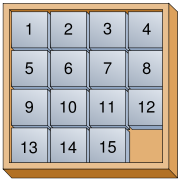- See the Wikipedia article on the Fifteen Puzzle for a description of the puzzle.
- You will implement by using:
- pair programming
- documented stubs
- user stories
- Deliverables, as described below, include a UML class diagram, user stories, html javadoc-generated documentation, and your code.
